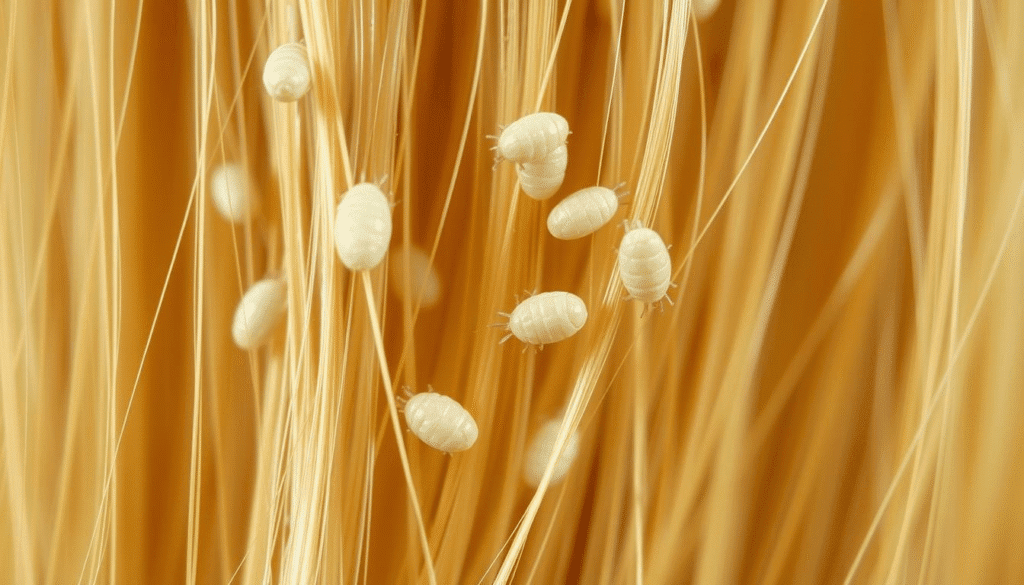Every year, over 12 million people in the U.S. get head lice. But dead lice nits in blonde hair can stay long after the live ones are gone. These tiny shells stick to hair, making it hard to get rid of them. Dead lice nits in blonde hair are almost invisible. They blend in with light hair. They don’t move but stay put, causing problems if not removed during treatment.
Understanding Lice Nits in Blonde Hair
What Are Lice Nits?

Lice nits are the tiny, oval-shaped eggs laid by head lice close to the scalp. Female lice attach these nits to individual strands of hair using a glue like secretion that is highly resistant to water and shampoo. Nits are usually yellowish-white or light brown and measure about 0.8 mm in length, making them difficult to distinguish from dandruff or hair debris.
Unlike dandruff, nits are firmly attached to the hair shaft and do not flake off easily. They typically hatch within 7 to 10 days, releasing immature lice called nymphs that begin feeding on blood from the scalp immediately. It’s important to note that once nits hatch, the empty shells remain stuck to the hair shaft and are often mistaken for live eggs, even though they are no longer viable.
Why Are Nits Harder to Spot in Blonde Hair?
Blonde hair presents a unique challenge when detecting lice nits because of the color similarity between the nits and the hair itself. Since nits are pale, whitish, or yellowish in appearance, they blend in more naturally with lighter hair tones. This camouflage effect makes visual identification particularly difficult, especially in natural or dim lighting.
Additionally, the fine texture of many blonde hair types may cause nits to lie flatter against the hair shaft, reducing their visibility even further. Standard lice checks may miss these nits unless a magnifying glass or nit detection comb is used under bright light. This difficulty in detection often leads to delayed treatment and increased chances of infestation spreading within households or classrooms.
Difference Between Live and Dead Lice Nits in Blonde Hair
Distinguishing between live and dead nits is critical to ensuring effective lice treatment. Live nits, also known as viable eggs, are generally located closer to the scalp within a quarter inch since warmth from the scalp is essential for incubation. These live nits often appear darker in color, indicating the developing louse inside.
In contrast, dead nits whether unhatched or empty shells after hatching are usually found further along the hair shaft as the hair grows out. They tend to appear lighter, more translucent, and can sometimes be crushed more easily. While dead nits pose no risk of further infestation, they remain glued to the hair and can be a cosmetic concern, especially in blonde hair where they’re more likely to be noticed once lighting conditions or angles change.
Why Dead Nits Are Difficult to Remove in Blonde Hair?
Color Camouflage and Visual Challenges
Dead nits are hard to spot in blonde hair because their color closely matches the hair itself. Nits are usually pale yellow, white, or translucent, which blends easily with light colored strands. This makes it difficult for parents or caregivers to see and remove them without the help of special lighting or magnifying tools.
Even under natural light, the reflection from blonde hair can make the nits almost invisible to the naked eye. As a result, many dead nits go unnoticed during combing and stay stuck to the hair shaft. This can cause confusion, making people think the lice are still active even if they are not. The lack of contrast between the nits and the hair is the biggest visual challenge in blonde hair types.
Differences in Hair Texture and Thickness
Blonde hair often has a finer and smoother texture compared to darker or thicker hair types. This silky texture allows the nit glue to stick more firmly and evenly to each hair strand. The glue produced by lice is very strong and water-resistant, which helps the nits stay attached, even after they’re dead. Because fine hair lies flat and doesn’t have much texture, there’s nothing to help loosen the nits naturally.
This makes manual removal more difficult, even when using a nit comb. In some cases, the smoothness of blonde hair also makes it harder for natural treatments to fully reach and break down the glue. These texture differences make nit removal slower and more frustrating in light-colored, fine hair.
Why Standard Shampoos Don’t Work?
Regular shampoos, including some over the counter lice treatments, are not designed to remove dead nits. These shampoos may kill live lice, but they do not break down the sticky glue that keeps nits attached to the hair shaft. The glue is made of a tough substance that resists water and shampoo ingredients, so even washing the hair several times won’t make the nits fall off.
This is why people often find dead nits still stuck to their hair after treatment, even though the lice are gone. Removing them usually requires extra help from vinegar rinses, natural oils, or fine-toothed nit combs.
Best Methods to Remove Dead Lice Nits
Fine Toothed Nit Combing Technique

This method involves using a specially designed metal or plastic nit comb with very closely spaced teeth to physically drag the nits off the hair shaft. Since dead nits are often stubbornly attached due to the glue like substance secreted by lice, combing must be done meticulously in small sections.
For best results, slightly dampen the hair and apply a detangler or conditioner to reduce friction. The comb should be passed through each section from scalp to tip while the hair is held taut to prevent discomfort.
Using Vinegar or Natural Acid Rinses
Vinegar, particularly white or apple cider vinegar, has long been regarded as a natural remedy for loosening the bond between dead lice nits and the hair shaft. Its mild acetic acid content helps break down the sticky glue that holds the nits in place, making it easier to comb them out. To use this method effectively, saturate the hair with diluted vinegar (a 1:1 ratio with warm water is often ideal) and allow it to sit for 15–20 minutes.
Covering the head with a shower cap can enhance the softening effect. After soaking, comb the hair thoroughly using a nit comb. Although vinegar does not kill lice or nits, it can aid significantly in the mechanical removal process, especially in fine, light-colored hair where nits are less visible but still stubbornly adhered.
Applying Essential Oils for Easier Removal
Essential oils like tea tree, lavender, eucalyptus, and neem are widely known for their natural insecticidal and antiseptic properties. While not all essential oils are scientifically proven to kill lice or their eggs, many of them can help loosen nits and soothe scalp irritation. When mixed with a carrier oil such as coconut or olive oil, essential oils can help soften the adhesive that holds dead nits to the hair shaft.
Applying the oil blend and letting it sit for at least 30 minutes can make nit combing more effective and less painful. For blonde hair, which is often more delicate and prone to drying out, these oils also offer a conditioning benefit. However, it’s essential to perform a patch test first to avoid allergic reactions, especially when using oils on children or sensitive scalps.
Heat and Blow Drying Method
Applying controlled heat through blow drying is another technique used to assist in the removal of dead lice nits. While heat itself doesn’t always loosen the glue, it can make the hair shaft more pliable and the nits easier to dislodge with a comb. Some professional lice removal systems use a specialized heated air device (like the AirAllé) designed to dehydrate lice and nits, but for home use, a standard blow dryer can help support the combing process.
Focus the dryer on low or medium heat to avoid scalp burns, and dry the hair in small sections while combing through with a nit comb immediately after. This method can be particularly helpful on blonde hair, which tends to tangle less when dried, allowing for smoother combing. It’s also useful as part of a larger lice treatment routine that includes manual and topical steps.
Post-Treatment Care and Prevention
Cleaning Hair Tools and Bedding
After removing lice and dead nits, it’s important to clean everything that may have come into contact with the hair. Combs, brushes, hair ties, and clips should be soaked in hot water at least 130°F for 10 to 15 minutes to kill any remaining lice or eggs. Wash all bedding, pillowcases, hats, scarves, and towels in hot water and dry them on high heat. Items that can’t be washed should be sealed in a plastic bag for at least two weeks.
How to Prevent Future Lice Infestations?
Preventing lice from coming back involves practicing good hygiene and staying cautious, especially in shared environments like schools or camps. Teach children not to share combs, hats, or pillows with others. Using lice-repelling sprays made with natural oils like tea tree or lavender can act as a barrier.
Keep long blonde hair tied back in braids or buns to reduce contact during play. Regularly vacuuming couches, car seats, and rugs can also remove stray lice. Staying aware and cautious helps reduce the chances of lice spreading again, especially if there was a recent outbreak in your household or community.
Routine Hair Checks for Early Detection

Even after successful treatment, regular scalp checks are key to catching any new lice early. Set aside time each week to examine the scalp under bright light, especially near the ears and neck where lice like to hide. Use a fine-toothed nit comb on slightly damp hair to scan for new lice or nits. In blonde hair, this is especially important because nits are hard to see without close inspection. Early detection makes treatment easier and prevents a full outbreak. Making this a weekly habit especially if your child attends school or daycare can help you stay ahead of lice before they spread again.
When to Seek Medical or Professional Help
Signs of Scalp Irritation or Infection
If the scalp becomes red, swollen, or develops sores during or after lice treatment, it may be a sign of irritation or even infection. Scratching can break the skin, allowing bacteria to enter and cause pain or pus-filled bumps. A foul smell, persistent itchiness, or yellow crusts are all warning signs that should not be ignored.
Lice Clinics vs In Home Treatments
Lice removal clinics offer specialized equipment and trained staff to handle tough infestations. They often use heat treatments that kill lice and nits in a single session. These clinics are ideal if you want a quick, medically guided solution. On the other hand, in home lice removal services bring professionals directly to your house, making it a convenient option for families with multiple affected members.
Both choices are more expensive than DIY methods but offer peace of mind and thorough results. Choosing between a clinic and in-home treatment depends on your budget, schedule, and comfort level but both are great for handling persistent lice problems.

 Medically reviewed by
Medically reviewed by